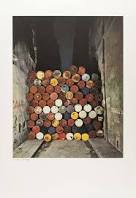Japanese Art - Nihonga Style

From around the start of the twentieth century, Nahonga art began to emerge as a major style of Japanese art. Nihonga is a pretty general term translating literally to mean "Japanese painting". Many Nihonga artist used this type of art to go against much of the Japanese adoption of Western artwork and styles, and they wanted to focus on the beauty and importance of Japanese art. " Nihonga emphasized using mineral based pigments and nikawa , a binding agent, and painting on scrolls and screens, to portray subjects like landscapes, kacho-ga (bird and flower paintings), bijin-ga (paintings of beautiful women), and scenes from Japanese culture and history." (Sieferle, 2018). "The Spirit of Japan" - Yokoyama Taikan This first painting, done in 1944 by Yokoyama Taikan is a piece of Nahonga art which was done in Japan. Taikan attended the Tokyo School of Fine arts and studied there. I selected this work because landscape artwork and pieces of art...





